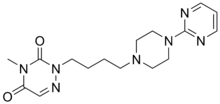
Summary
Eptapirone (F-11,440) is a very potent and highly selective 5-HT1A receptor full agonist of the azapirone family.[1][2] Its affinity for the 5-HT1A receptor was reported to be 4.8 nM (Ki) (or 8.33 (pKi)), and its intrinsic activity approximately equal to that of serotonin (i.e., 100%).[1]
 | |
| Clinical data | |
|---|---|
| Routes of administration | Oral |
| ATC code |
|
| Legal status | |
| Legal status |
|
| Pharmacokinetic data | |
| Elimination half-life | 2 hours |
| Identifiers | |
| |
| CAS Number |
|
| PubChem CID |
|
| ChemSpider |
|
| UNII |
|
| CompTox Dashboard (EPA) |
|
| Chemical and physical data | |
| Formula | C16H23N7O2 |
| Molar mass | 345.407 g·mol−1 |
| 3D model (JSmol) |
|
| |
| |
Eptapirone and related high-efficacy 5-HT1A full and super agonists such as befiradol and F-15,599 were developed under the hypothesis that the maximum exploitable therapeutic benefits of 5-HT1A receptor agonists might not be able to be seen without the drugs employed possessing sufficiently high intrinsic activity at the receptor. As 5-HT1A receptor agonism, based on animal and other research, looked extremely promising for the treatment of depression from a theoretical perspective, this idea was developed as a potential explanation for the relatively modest clinical effectiveness seen with already available 5-HT1A receptor agonists like buspirone and tandospirone, which act merely as weak-to-moderate partial agonists of the receptor.[1][2][3][4][5]
Animal studies edit
In the Porsolt forced swimming test, eptapirone was found to suppress immobility more robustly than buspirone, ipsapirone, flesinoxan, paroxetine, and imipramine, which was suggestive of strong antidepressant-like effects.[1] In this assay, unlike the other drugs screened, buspirone actually increased the immobility time with a single administration, while repeated administration decreased it, an effect that may have been related to buspirone's relatively weak intrinsic activity (~30%) at the 5-HT1A receptor and/or its preferential activation of 5-HT1A somatodendritic autoreceptors over postsynaptic receptors.[1]
After repeated administration, high dose paroxetine was able to rival the reduction in immobility seen with eptapirone. However, efficacy was seen on the first treatment with eptapirone, which suggested that eptapirone may have the potential for a more rapid onset of antidepressant effectiveness in comparison.[1] Imipramine was unable to match the efficacy of eptapirone or high dose paroxetine, which was probably the result of the fact that higher doses were fatal.[1]
In the conflict procedure, eptapirone produced substantial increases in punished responding without affecting unpunished responding, which was suggestive of marked anxiolytic-like effects.[1] In addition, the efficacy of eptapirone in this assay was more evident than that of buspirone, ipsapirone, and flesinoxan.[1]
Human studies edit
Eptapirone has been assayed in humans in preclinical trials at an oral dose of 1.5 mg.[6][7] In these studies, eptapirone reduced body temperature, prolonged REM sleep, increased cortisol and growth hormone levels, and produced side effects such as dizziness and drowsiness while being overall well tolerated.[6][7] It peaked rapidly within 30–60 minutes and had an estimated half-life of two hours, with a total duration of approximately three hours.[6][7]
See also edit
References edit
- ^ a b c d e f g h i Koek W, Patoiseau JF, Assié MB, et al. (October 1998). "F 11440, a potent, selective, high efficacy 5-HT1A receptor agonist with marked anxiolytic and antidepressant potential". The Journal of Pharmacology and Experimental Therapeutics. 287 (1): 266–83. PMID 9765347.
- ^ a b Prinssen EP, Colpaert FC, Koek W (October 2002). "5-HT1A receptor activation and anti-cataleptic effects: high-efficacy agonists maximally inhibit haloperidol-induced catalepsy". European Journal of Pharmacology. 453 (2–3): 217–21. doi:10.1016/S0014-2999(02)02430-5. PMID 12398907.
- ^ Celada P, Bortolozzi A, Artigas F (September 2013). "Serotonin 5-HT1A receptors as targets for agents to treat psychiatric disorders: rationale and current status of research". CNS Drugs. 27 (9): 703–16. doi:10.1007/s40263-013-0071-0. hdl:10261/88633. PMID 23757185. S2CID 31931009.
- ^ Koek W, Vacher B, Cosi C, et al. (May 2001). "5-HT1A receptor activation and antidepressant-like effects: F 13714 has high efficacy and marked antidepressant potential". European Journal of Pharmacology. 420 (2–3): 103–12. doi:10.1016/S0014-2999(01)01011-1. PMID 11408031.
- ^ Maurel JL, Autin JM, Funes P, Newman-Tancredi A, Colpaert F, Vacher B (October 2007). "High-efficacy 5-HT1A agonists for antidepressant treatment: a renewed opportunity". Journal of Medicinal Chemistry. 50 (20): 5024–33. doi:10.1021/jm070714l. PMID 17803293.
- ^ a b c Wilson SJ, Bailey JE, Rich AS, et al. (November 2005). "The use of sleep measures to compare a new 5HT1A agonist with buspirone in humans". Journal of Psychopharmacology. 19 (6): 609–13. doi:10.1177/0269881105058775. PMID 16272182. S2CID 34590219.
- ^ a b c Wilson SJ, Bailey JE, Nutt DJ (June 2005). "Dizziness produced by a potent 5HT(1A) receptor agonist (eptapirone) is not due to postural hypotension". Psychopharmacology. 179 (4): 895–6. doi:10.1007/s00213-004-2111-4. PMID 15619110. S2CID 27804035.


